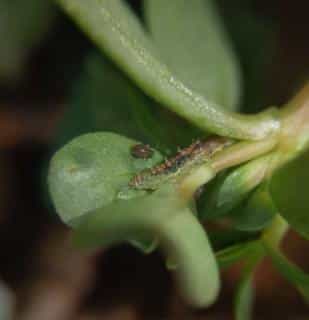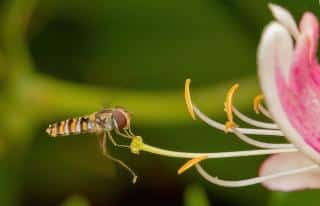

The hoverfly: even if the name doesn’t ring a bell, you’ve probably seen them before and wondered what kind of insect this was. In spring and summer, one often sees them flying around, hovering at a standstill around melliferous flowers and trees.
These beneficial insects are incredible pollinators and their larvae are a very effective help when dealing with aphids.
Read also:
Technically, we should be talking about hoverflies – there are more than one species of hover fly. Indeed, the Syrphidae family numbers in the thousands, each continent home to over 500 species. Depending on the species, the size they reach as adults ranges from 1/10th to 1 inch (3 to 25 mm).
One of the most intriguing particularities of the hoverfly gave it its name: it masters stationary flight thanks to the blindingly fast beating of its wings (120 beats per second!). This characteristic, when seconded with the observation of the insect’s black and yellow exoskeleton, makes identifying the insect very easy.
As the title of the post shows, there are several benefits of having hover flies visit your garden often:
 Adults feed on nectar and pollen. As such, they are formidable pollinators that clearly deserve a welcome in the vegetable patch and orchard. They’ll work tirelessly at this task alongside bees and lacewing.
Adults feed on nectar and pollen. As such, they are formidable pollinators that clearly deserve a welcome in the vegetable patch and orchard. They’ll work tirelessly at this task alongside bees and lacewing.Hoverflies gather large amounts of pollen. Its availability is actually crucial for female fertility. So if your goal is to is to increase biodiversity in your garden and attract this beneficial insect inside it, all you need to do is:
 sow a wildflower strip in which composite and umbel flowers complement each other: include yarrow, aster, masterwort, etc.;
sow a wildflower strip in which composite and umbel flowers complement each other: include yarrow, aster, masterwort, etc.;Note that hoverflies also love woody forests, which not only provides them with food, but with lots of places to hibernate during winter. Thanks to these many functions, the hoverfly earns the title of “excellent beneficial insect”! Include it in your plants to attain organic control of pests and diseases.